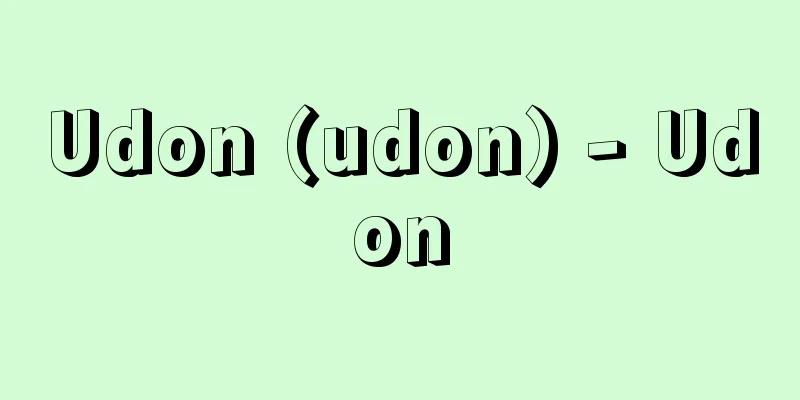Burns

|
A slang term for burns. Also called burns caused by flames. Damage to the skin or mucous membranes caused by contact with high-temperature gas (including flames), liquids, or solids. In severe cases, it can cause systemic symptoms and even death. Chemicals can also cause similar symptoms, and are called chemical burns. Electricity-related injuries are treated separately as electric shock injuries. The severity of a burn depends on the temperature of the heat applied and the duration of exposure. Therefore, even if the heat is high, if the exposure is short, the injury will be minor, but if the heat is relatively low and the injury is long-lasting, deep ulcers will form. Typical examples of the latter are burns caused by hot water bottles or electric heaters, most of which leave scars requiring surgery. The severity of a burn, i.e., whether or not shock symptoms will occur, is determined by the area and depth of the injury, the location of the injury, the circumstances at the time of the injury, the presence or absence of complications, and the child's age. For example, if the injury involves the face, hands, feet, or vulva, care is required. If the injury is accompanied by airway burns or fractures, which are seen in fires, the injury is severe. Also, care is required for children under 1 year old and over 60 years old. [Hiromi Mizutani] Calculation method for the area of injuryThe area of the burn must be calculated as accurately as possible, since it is extremely important for determining the prognosis and treatment, especially the amount of fluid to be administered. There are various methods of calculation, but the "rule of nines" is the most common as a rough guide in emergency situations. The slightly more complicated "rule of fives," which takes age differences into account, is also often used. These "rules" are used as indicators of the percentage of the total surface area that is burned. For example, the "rule of nines" used for adults dictates that the face and head account for approximately 9%, the arms for each side, and the lower limbs for each side, each 18%. For children, the composition ratio is different from that of adults, so the "rule of fives" and the "Rand-Browder chart," which divides the area into smaller areas according to growth stage, are used. [Hiromi Mizutani] Burn Depth ClassificationBurn depth is divided into first degree, second degree and third degree, and second degree burns are further divided into shallower second degree and deeper second degree. The characteristics and treatment policy of each are as follows. (1) First degree (superficial burn): The skin becomes red and tingly, and there is slight swelling, but no blisters develop. It heals within a few days and does not leave a scar, although temporary pigmentation may remain. (2) Second degree (superficial and deep dermal burns) Blisters appear within a few to 24 hours, and when they burst, the surface becomes eroded and produces a large amount of secretion. Shallow burns heal in about two weeks, leaving behind slight scars, but deep burns take two to three weeks for the epidermis to fully form, leaving behind quite noticeable scars. Even shallow second degree burns can easily progress to deep second degree burns if treatment is incorrect and infection occurs, so care must be taken. (3) Third degree (subcutaneous burn): The burn becomes necrotic, and the surface becomes hard and dry, with a pearly, yellowish or grayish black color, and is not painful to the touch. Since all epidermal components are lost, epidermal formation is unlikely, and skin grafts are usually required. Over a very long period of time, the wound may close leaving a severe scar, but functional disorders such as contractures may occur. In addition, after 10 to 30 years, squamous cell carcinoma may develop on the scars of severe burns. [Hiromi Mizutani] Systemic symptoms in severe burnsBurns involving 10% or more of the body surface area can cause shock, regardless of the severity. (1) Primary shock: This is a circulatory disorder caused by vasomotor reflexes and occurs within 1 to 2 hours. (2) Secondary shock: Severe circulatory disorder caused by loss of bodily fluids, electrolyte imbalance, blood thickening, hemolysis, etc., which occurs 2 to 48 hours later. Symptoms begin with pale skin, dry mouth, frequent yawning, cold extremities, and nausea, followed by fever, drop in blood pressure, and decreased urine output. If left untreated, a lack of oxygen to the brain can cause excitement, violence, convulsions, vomiting, and other symptoms, resulting in an extremely dangerous condition. If the patient survives the shock period of 1-2 days after injury, they will enter a recovery period after going through a shock recovery period (2-7 days), a malnutrition or infection period (8-21 days). During this time, complications in various organs may occur. A well-known example is Curling ulcer, which causes sudden bleeding from the upper digestive tract (stomach and duodenum). Other common complications include a temporary rise in blood sugar levels due to stress, and abnormalities in the functioning of the thyroid gland and the gonads. [Hiromi Mizutani] TreatmentBurn treatment has made great advances since the two world wars in the 20th century, and in recent years, many seriously injured patients have been saved and have been rehabilitated to return to society. However, in Japan, there are still many issues with the emergency medical care system for burns. There are few facilities that can be called burn centers or burn units, and a consistent treatment system that includes everything from emergency life-saving measures to the functional training necessary for social reintegration has not been established. However, the Japan Society for Burn Injuries published the "Burn Care Guidelines" in 2009 (Heisei 21) with the aim of standardizing burn treatment. (1) Systemic therapy When the injured area exceeds 20% in adults and 10% in children, careful systemic management is required. The severity of the injury is quickly assessed by listening to the details of the injury and fluid infusion is started if necessary, but it is important that this is done appropriately. After surviving the shock stage, the main focus is on nutritional support and the treatment and prevention of infection. In recent years, the survival rate of burn patients has improved and the mortality rate during the shock stage has decreased, but the subsequent mortality rate due to infection has not decreased. (2) Local treatment: Immediately after the injury, it is best to cool the area with running water. In cases where the injury is caused by acid or alkali, it is especially important to wash the area thoroughly. After that, wrap the area in a clean cloth and visit a doctor. It is best not to apply tincture oil or other substances at home, as this can cause infection and interfere with treatment. Medications commonly used for local therapy include disinfectants such as Hibitane solution and Isodine solution, antibiotic ointments, mesh gauze, and also sterilized freeze-dried pigskin as a bio-dressing. Creams containing silver sulfadiazine are highly effective against Pseudomonas aeruginosa infections, which are common in extensive burns, and have few side effects. The principle of local therapy is to aid the natural healing process, but it is also important to combine it with surgical therapy such as skin grafting to minimize aftereffects. Treating burns in special areas such as the face, hands, joints, and vulva requires specialized knowledge and techniques for each area. [Hiromi Mizutani] "Burns" edited by Kan Sugimoto et al. (1983, Nanzando) " Guidelines for the Treatment of Burns, edited by the Academic Committee of the Japanese Society for Burn Injuries (2009, Japanese Society for Burn Injuries)" [References] | |Source: Shogakukan Encyclopedia Nipponica About Encyclopedia Nipponica Information | Legend |
|
熱傷の俗称。火炎などによる場合は火傷ともいう。高温の気体(火炎を含む)、液体、固体に触れることによって生ずる皮膚や粘膜の損傷で、重症のものでは全身症状を呈し、死に至ることもある。化学薬品でも同様の症状を呈し、化学熱傷という。電気によるものは電撃傷として別に扱われる。 熱傷の程度は、作用した熱の温度と作用時間によって決まる。したがって高温でも作用時間が短ければ軽症ですむが、比較的低温でも長時間作用すれば深い潰瘍(かいよう)となる。後者の代表例は湯たんぽや電気行火(あんか)による熱傷で、大部分が手術を必要とする傷を残している。 やけどの重症度、すなわちショック症状をおこすかどうかの判定は、受傷面積と傷の深さ、受傷部位、受傷時の状況と合併症の有無、および年齢などによって決まる。たとえば顔面、手、足、外陰部などを含む場合は注意が必要で、火災時にみられる気道熱傷や骨折などの外傷を伴うときは重傷であり、また1歳以下および60歳以上の場合も要注意である。 [水谷ひろみ] 受傷面積の算定法受傷面積は、予後の判定や治療法、とくに輸液の量の決定にもきわめて重要なので、できるだけ正確に算定する必要がある。計算方法は種々知られているが、救急時のおおよその目安としては「9の法則」がもっとも一般的である。これよりやや複雑で年齢差を考慮に入れた「5の法則」もよく用いられる。これらの「法則」は、熱傷箇所が全体表面積のどのくらいの割合(%)を占めるかという指標として用いられる。たとえば、成人の場合に用いられる「9の法則」では、顔・頭が約9%、腕は左右それぞれ約9%、下肢は左右それぞれ約18%にあたることが基準となっている。また、小児の場合は、構成比が成人とは異なるため「5の法則」や成長段階によって細かく分けた「ランド・ブラウダーチャート」が用いられる。 [水谷ひろみ] 熱傷深度の分類熱傷深度は第一度から第三度に分け、第二度熱傷はさらに浅い第二度と深い第二度に分けられる。それぞれの特徴や治療方針は次のとおりである。 (1)第一度(表皮熱傷) 皮膚が赤くなり、ひりひりする程度で、浮腫(ふしゅ)(むくみ)もわずかにみられるが水疱(すいほう)(水ぶくれ)は生じない。数日で治り、あとに瘢痕(はんこん)を残さないが、一時的に色素沈着を残すことはある。 (2)第二度(真皮浅層熱傷および真皮深層熱傷) 数時間から24時間で水疱を生じ、これが破れると、びらん面となり多量の分泌液が出る。浅いものは2週間前後で軽い瘢痕を残して治癒するが、深い場合は表皮形成完了までに2~3週間を要し、かなり目だつ瘢痕を残す。また浅い第二度でも治療を誤って感染をおこすと、容易に深い第二度へ移行するので注意を要する。 (3)第三度(皮下熱傷) 壊死(えし)に陥り、表面は硬く乾いた真珠色、黄色調または灰黒色調を呈し、触れても痛みを感じない。表皮成分をすべて失っているので表皮形成はほとんど期待できず、通常は皮膚移植を必要とする。非常に長い期間をかければ高度の瘢痕を残して創面は閉鎖することもあるが、ひきつれなどによる機能障害をおこしやすい。また、高度の熱傷瘢痕上に、10~30年くらいの経過で有棘(ゆうきょく)細胞癌(がん)が発生することがある。 [水谷ひろみ] 重症熱傷時の全身症状体表面積10%以上の熱傷では、多少にかかわらずショック症状をおこす危険がある。 (1)一次ショック 血管運動神経の反射による血行障害で、1~2時間後におこる。 (2)二次ショック 体液の喪失、電解質平衡の乱れ、血液濃縮、溶血などによる高度の循環障害で、2~48時間後におこる。皮膚が蒼白(そうはく)化し、口が乾く、あくびを連発する、四肢が冷たい、吐き気がするなどの症状で始まり、発熱、血圧降下、尿量の減少などがみられる。放置すると、脳の酸素不足により、興奮、狂暴、けいれん発作、嘔吐(おうと)などをきたし、きわめて危険な状態になる。 受傷後1~2日のショック期を切り抜けると、ショック離脱期(2~7日)、低栄養期または感染期(8~21日)を経て回復期に入る。その間種々の臓器の合併症がおこりうる。有名な例はカーリングCurling潰瘍で、突然に上部消化器(胃、十二指腸)から出血する。また、ストレスによる一時的な血糖値上昇、甲状腺(せん)や性腺の機能異常などもよくみられる。 [水谷ひろみ] 治療熱傷の治療は、20世紀の2回の世界大戦を経て非常に進歩し、近年はかなりの重症者が救命され、リハビリテーションを経て社会復帰に至っている。しかし日本では、熱傷の救急医療体制には、まだ課題も多い。熱傷センター、熱傷ユニットとよべる施設は少なく、また救急救命措置から社会復帰に必要な機能訓練までを含めての一貫した治療システムは確立されていなかったが、日本熱傷学会では2009年(平成21)に「熱傷診療ガイドライン」を刊行し、熱傷治療の標準化を目ざしている。 (1)全身療法 受傷面積が成人で20%、小児で10%を超えるときは慎重な全身管理が必要になる。受傷状況を詳しく聞きながらすばやく重症度の判定をし、必要に応じて輸液を開始するが、これが適切に行われるかどうかが重要となる。ショック期を切り抜けた後には栄養補給と感染症の治療、予防が主体となる。近年、熱傷患者の救命率は向上し、ショック期の死亡率は低下しているが、その後の感染症に起因する死亡率は依然として低下していないという傾向にある。 (2)局所療法 受傷直後には流水でどんどん冷やすのがよい。酸やアルカリによる場合はとくに十分洗い流す必要がある。その後、清潔な布で患部を包んで受診し、自宅ではチンク油などを塗らないほうがよい。感染の原因になり、治療にも差し支えるからである。 局所療法として通常用いられる薬剤は「ヒビテン液」「イソジン液」などの消毒液、抗生物質入りの軟膏(なんこう)やメッシュガーゼ、そのほか生体包帯としての滅菌凍結乾燥豚皮も頻用されている。広範囲熱傷時におこりやすい緑膿(りょくのう)菌感染にはスルファジアジン銀入りのクリームが優れた効果を示し、副作用も少ない。局所療法の原則は自然治癒過程を助けることにあるが、後遺症を最小限にとどめるためには植皮術などの外科的療法を併用することもたいせつである。とくに顔、手、関節、外陰部など特殊領域の熱傷治療には、それぞれの部位に関する専門知識と技術が必要である。 [水谷ひろみ] 『杉本侃他編『熱傷』(1983・南江堂)』▽『日本熱傷学会学術委員会編『熱傷診療ガイドライン』(2009・日本熱傷学会)』 [参照項目] | |出典 小学館 日本大百科全書(ニッポニカ)日本大百科全書(ニッポニカ)について 情報 | 凡例 |
Recommend
yatra (English spelling)
…In addition, a genre called muhūrta was establis...
Kallinikos
...Population: about 35,000. Greek name: Nikēphor...
Italian Music - Italian Music
In the 2000-year history of Western art music, It...
Hatano Kengyo
Year of death: 1651 (Keian 4?) Year of birth: Unkn...
Internal division - internal division
〘noun〙① division. ② something that is kept secret ...
Water arum
A perennial marsh plant (illustration) of the Arac...
Asmodeus
...A demon that appears in the Old Testament apoc...
Sakata [city] - Sakata
A city in northwest Yamagata Prefecture. It was in...
Anal tribe - Anal tribe
… [Solar Eclipse and Sun Worship] Myths and ideas...
Het - Het
A fat obtained by leaching from the fat tissue of...
Brotherhood of Faith - Kyodai Shinjinkai
...Strikes against employers were often launched,...
Pennant, T. (English spelling) PennantT
…English clergyman and naturalist. While serving ...
Codonophilus trigonocephalus (English spelling)
…It is commonly found along the coast of Japan. I...
United States Education Mission to Japan
After World War II, the US government dispatched ...
OBJ - Obij
...This is called the implementation of an abstra...









